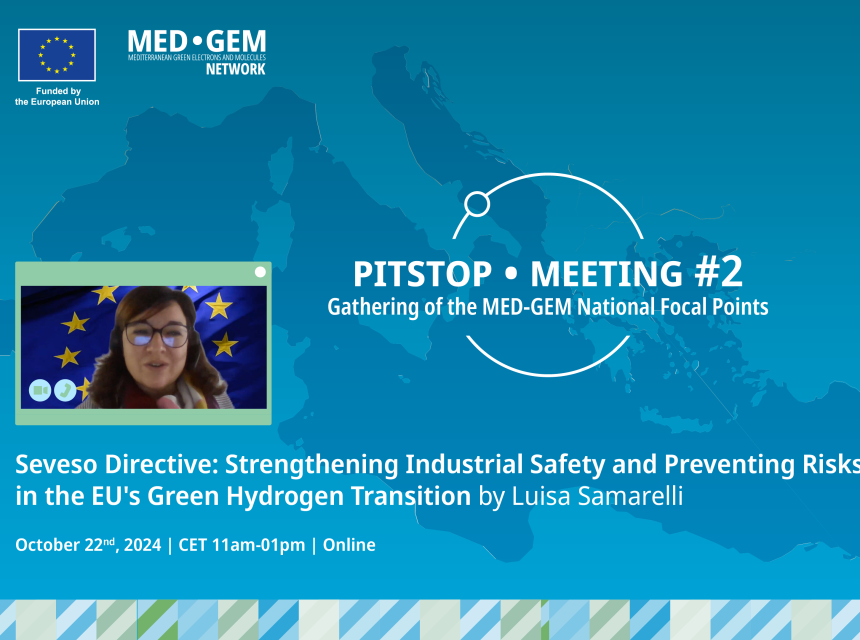Seveso Directive: Strengthening Industrial Safety and Preventing Risks in the EU's Green Hydrogen Transition
On October 22, 2024, Mrs Luisa Samarelli, Deputy Head of Unit at DG Environment at the European Commission, presented an in-depth review of the Seveso Directive during the MED-GEM Network’s mid-term Steering Committee meeting. In her presentation, Mrs outlined the EU’s legislative framework for preventing industrial accidents, tracing its evolution from the 1976 Seveso disaster to the latest amendments that integrate the principles of the European Green Deal. With a focus on safety standards for green hydrogen and ammonia production, her session addressed key regulatory challenges and highlighted the importance of risk management in supporting the EU's energy transition.
In recent decades, industrial accidents across the European Union (EU) have underscored the need for a robust regulatory framework to mitigate risks and protect communities. During the recent "Pitstop Meeting" of the MED-GEM Network's Steering Committee, Mrs. Luisa Samarelli, Head of Unit at DG Environment, provided an in-depth presentation on the EU’s regulatory framework, particularly focusing on the Seveso Directive. This legislation is pivotal in preventing industrial accidents and minimizing their impacts. This report highlights the key points from her presentation, detailing the evolution of the Seveso Directive, its implications for public safety, environmental protection, and the broader goals of the European Green Deal.
Origins of the Seveso directive
The Seveso Directive was born out of a tragic chemical accident in 1976 in Seveso, Italy, when the release of toxic dioxins from a chemical plant led to widespread environmental and health damage. This incident, along with over 900 major accidents across the EU in subsequent years, pushed the EU to develop a comprehensive regulatory framework for preventing industrial disasters. Initial legislation was introduced in 1982, but subsequent events like the Bhopal disaster (1984) and the contamination of the Rhine (1986) revealed the need for continual improvement.
Key legislative developments
The Seveso Directive has evolved significantly over time. The adoption of the Seveso II Directive in 1996 marked a turning point, introducing more stringent safety management systems, emergency planning requirements, and mandatory inspections. However, further incidents, such as the fireworks explosion in the Netherlands and the ammonium nitrate blast in Toulouse, prompted additional revisions. By 2015, the Seveso III Directive came into effect, expanding its scope to include more substances and improving land-use planning to account for potential accident risks.
The impact of industrial accidents
Industrial accidents have far-reaching consequences, including immediate loss of life, long-term environmental damage, and economic disruption. A study estimated that major accidents cost the EU around €3.7 billion annually, with each incident averaging €150 million in damages. These accidents also have profound social impacts, including job losses, community displacement, and psychological stress.
Integrating the european Green Deal
The Seveso Directive forms a key part of the EU’s commitment to environmental and public safety, aligning with the European Green Deal’s zero-pollution ambition. This initiative seeks to eliminate harmful pollution, enhance air and water quality, and create a safer environment. The directive, together with the Green Deal’s broader goals, reflects the EU’s holistic approach to environmental sustainability and industrial safety.
Regulatory framework and implementation
The Seveso Directive currently applies to over 12,000 industrial sites across Europe, categorized as either lower-tier or upper-tier establishments based on the quantity of hazardous substances. Upper-tier facilities are subject to stricter regulations, including rigorous safety management, risk assessment, and emergency preparedness. Operators must implement comprehensive internal emergency plans, while public authorities are responsible for external plans in case of accidents.
Q&A Session and key insights
The session concluded with an engaging Q&A, where participants sought to clarify specific aspects of the EU’s regulatory framework, particularly concerning hydrogen and ammonia safety standards. Imad Khatib raised important questions about the integration of Environmental Impact Assessments (EIA) and audit processes, with Mrs Samarelli referencing the Bhopal disaster as a crucial learning point for the directive’s evolution.
Frank Wouters inquired about the regulatory oversight of materials used in hydrogen electrolyzers, especially concerning debates around per- and polyfluoroalkyl substances (PFAS).
Meshi Laks addressed the thresholds for hydrogen production, while Mustapha Taoumi explored the possibility of member states imposing stricter regulations than those mandated by EU directives. Mrs Samarelli confirmed that EU law allows for more stringent national regulations, reflecting individual countries' safety concerns.
Finally, Bandaly El Issa emphasized the safety challenges posed by ammonia, with Mrs Samarelli detailing how the EU's directives address the risks associated with this hazardous substance.
Mrs Samarelli concluded the session by encouraging attendees to collaborate with the Joint Research Centre (JRC) for further technical discussions.
Conclusion
The EU’s regulatory framework for industrial accident prevention, exemplified by the Seveso Directive, is essential to ensuring the safety of citizens and the protection of the environment. As part of the European Green Deal, it plays a crucial role in promoting sustainability and preventing pollution. Through continued vigilance, regular updates, and collaboration across sectors, the EU aims to safeguard its industrial landscape while fostering a green and sustainable future.
Learn more on how European Commission is Industrial safety preventing and mitigating the risk of industrial accidents:
https://environment.ec.europa.eu/topics/industrial-emissions-and-safety/industrial-accidents_en
Learn more on the European Green Deal:
https://commission.europa.eu/strategy-and-policy/priorities-2019-2024/european-green-deal_en

